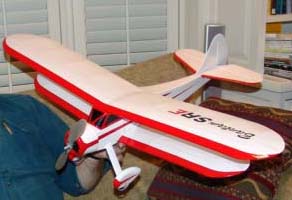 |
Flying High With Electric Power!
The Ampeer ON-LINE!
Fly the Future - Fly Electric! |
Site Table of Contents
| President: | Vice-President: | Secretary/Treasurer: |
| Ken Myers | Richard Utkan | Rick Sawicki |
| 5256 Wildcat | 240 Cabinet | 5089 Ledgewood Ct. W. |
| Croswell, MI 48422 | Milford, MI 48381 | Commerce Twp., MI 48382 |
| (810) 679-3238 | (248) 685-1705 | 248.685.7056 |
 | ||
| Board of Directors: | Board of Directors: | Ampeer Editor |
| David Stacer | Jack Lemon | Ken Myers |
| 16575 Brookland Blvd. | 8908 Sandy Ridge Dr. | 5256 Wildcat Rd. |
| Northville, MI 48167 | White Lake, MI 48386 | Croswell, MI 48422 |
| 248.924.2324 | 248.698.4683 | 810.679.3238 |
| Mailed Ampeer subscriptions are $10 a year US & Canada and $17 a year world wide. FREE on-line! | ||
| The Next Meeting: Date: Saturday, May 13 Time: 10:00 a.m. Place Midwest RC Society 5 Mi. Rd. Flying Field | ||
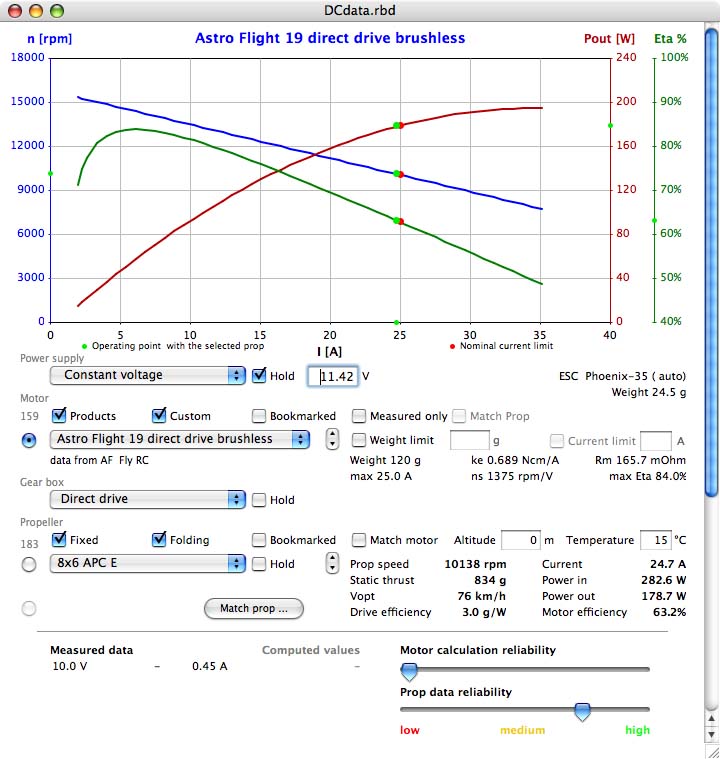
|
I put the data from the AF site and Fly RC review into Drive Calculator 3 and was surprised at what I saw. I had to revise the data over and over, since NONE of it was worked. I finally came up with the screen capture shown above. I cannot say with certainty that this screen capture actually reflects this motor, but if it does, it can be seen that using the APC 8x6E or larger prop is pushing this motor way past its most efficient operating range of 4 amps to 8 amps.
The volts appeared to be too high for the amp draw when compared to the rest of the voltage readings in the Performance Testing data on p. 46. 
Graph 1 I put the Fly RC data into an Excel spreadsheet to see what it would show me about the data. Graph 1 above was arranged by the reported amp draw. It wasn't exactly what I expected to see. I thought that it might be a bit straighter.
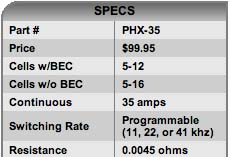
Web site 
.pdf documentation (Enough to drive you crazy isn't it!) Voltage drop through controller: 0.0045 * 25.3 = 0.114v
More Info on Keith Shaw's Bantam SRE
The January 2006 issue of the Ampeer had a photo of Keith Shaw with his Bantam SRE, a kind of stand off version of a WACO SRE kit-bashed from the SR Batteries (srbatteries.com) Bantam biplane kit.
Upcoming RAMS Meet The Radio Aeromodelers of Seattle is hosting the RAMS/PSEMF Electric Fly-In on June 24 and 25. The contest will be held at the RAMS field in Sumner, WA. Take Hwy 167 to 24th St. exit, to West Valley Hwy. It is about 1/4 mile to the RAMS field. The event begins each day at 8:00 a.m. The contact person is Randy Smithhisler at 253.927.4672 or rsmithhisler@paccar.com. The following events are scheduled: Class A Battery Allotment AMA #609 - 1 round daily Most Impressive - Contestants vote Best Multi-motor - CD's choice Best Scale - CD's choice Best Aerobatic - CD's choice Best Thermal - CD's choice Best Trainer - CD's choice This is the longest running electric event in the country. You are invited to come and watch these incredible aircraft in action in the hands of some of the best radio control pilots in the Pacific Northwest.
Upcoming E-FLI-OWA September 9 & 10
$15.00 landing fee covers both days and includes a raffle ticket for prizes donated by our vendors.
This will be a fun-fly only.
Great Eats!
For more information contact:
An Adjustable Width Hot Wire Bow -- Design Notes:
To build a hot wire foam-cutting bow I used a scrap 2 x 6 that I cut into 1 x 1 1/2 strips. You could use a 2 x 4 to do the same thing. I wanted a bow that could be used to cut various size parts for aero-modeling, so I designed its cutting width to be adjustable. The adjustable part of the design came about because I didn't have the room to store multiple bows. 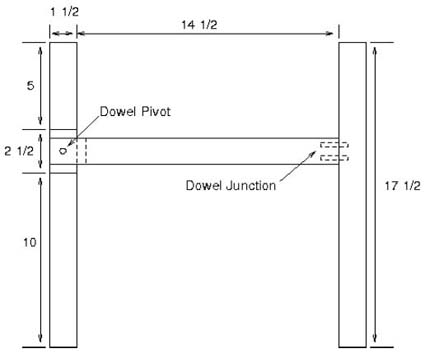 I used 3/8-inch diameter dowel to connect the various parts. Even the bow's pivot uses a dowel. The dowels, used to connect the various sections, are all 2 inches in length. They provide a strong, stable, and removable junction. It is relatively easy to adjust the bow's width by adding or removing an extension. 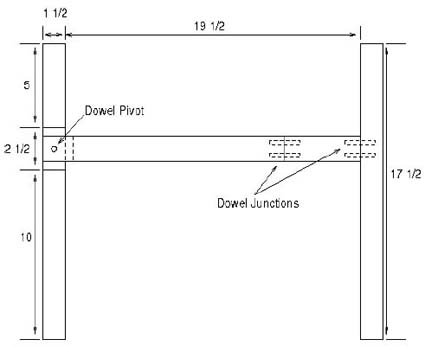 The next figure shows a detailed graphic of a dowel junction. These can be combined to give a bow of almost any desired width. |
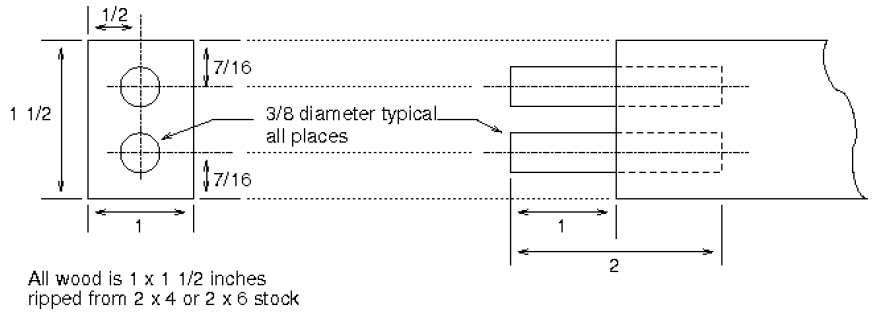
|
The most critical fabrication step is in drilling accurate 3/8-inch holes. The holes must all be parallel with the major axis of the beam. I used a drilling jig to ensure all holes were true. Furthermore, I started with a 1/16 inch bit and walked my way up to 3/8 inch using four bits. Otherwise you will loose accuracy and have poor alignment between beams.
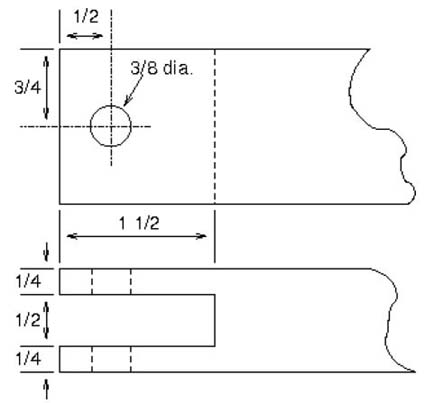 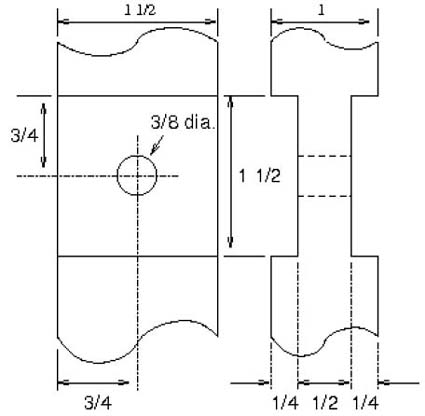 The right hand bow handle is detailed below at the dowel junction. It is relatively simple by comparison (see the full bow view at the beginning of the article). |
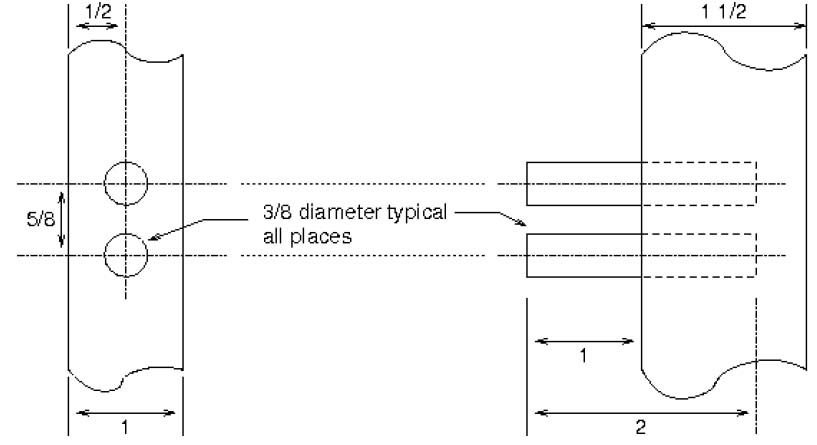
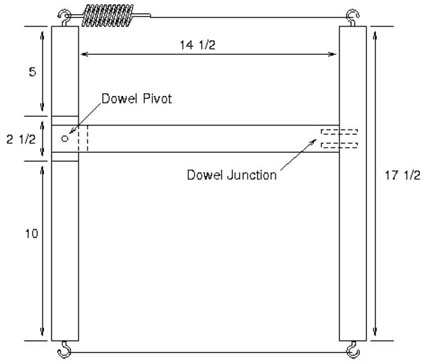 Above is a figure showing the bow with the rest of the hardware (hooks, spring, and stainless steel wire). As can be seen, I used hooks to attach the spring and the wires. This allows for easy replacement, and the bow's width can be adjusted by changing the lengths of the wires. 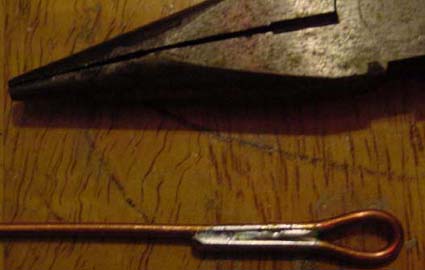 To attach the spring to its neighboring eyehook I used some old copper wire I had lying around -- this is just a piece of scrap romex safety wire.
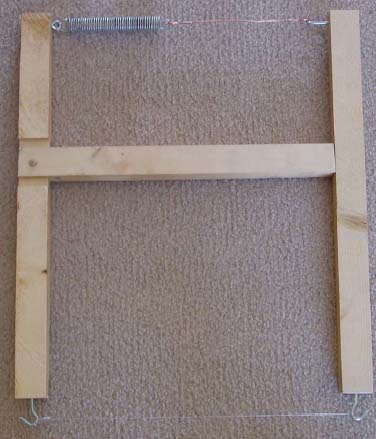 The photo shows the completed bow in its narrowest width configuration. You can see the spring being held under tension by the wire with soldered loops. The "extended version" looks the same, just wider.
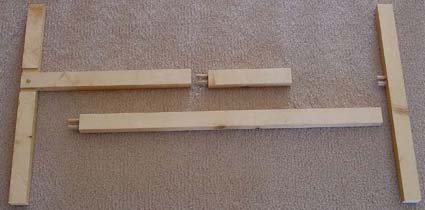 The bow works as expected. In my tests, using a high current DC power supply, I found that thicker stainless wire is needed to cut dense foam. Thicker wire, i.e., smaller gauge, can handle higher currents and is mechanically stronger.
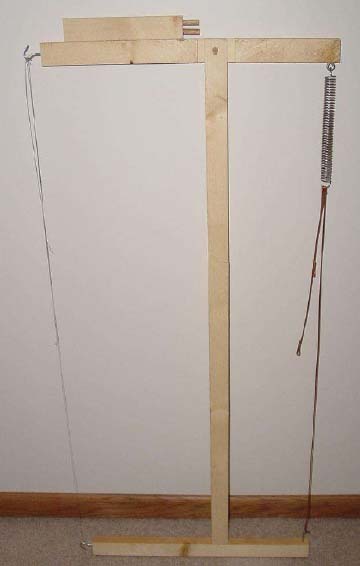 Jim Yuzwalk
March EFO Meeting The March 2006 EFO meeting was held at Rick Sawicki's house in Commerce Township and was a great night of sharing. Dave Stacer had prepared a really great video of us flying in Rick's basement at the February meeting. Many of you saw a little clip from this video if you checked out the March Ampeer. Thanks Dave, really great and lots of fun. Roger Wilfong shared his Astro Flight 035 powered Clancy Lazy Bee. He chose the colors because he likes them, and he also had them on hand. Very nice. 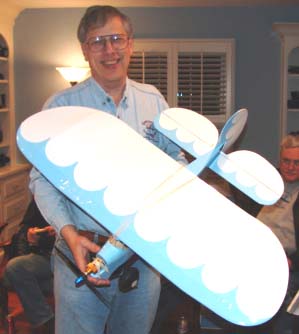 It turned out to be boat night at the flying club meeting.
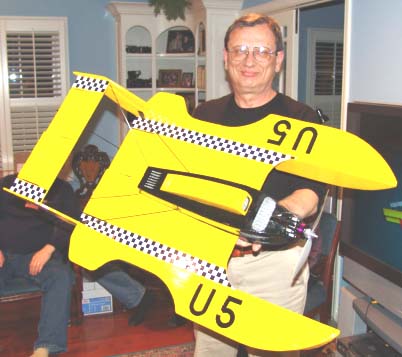 Richard Utkan shared a blue foam version of a flying hydro that he had picked up at swap shop. The plans were printed on the foam. He got a lot of advice as to how to finish it up. 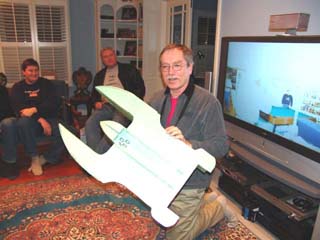 There was a lot of sharing of ideas by all of the members in attendance. That is the greatest thing about our EFO meetings; they are about model airplanes or related activities!
The Keith Shaw's Birthday Electric Fly
|
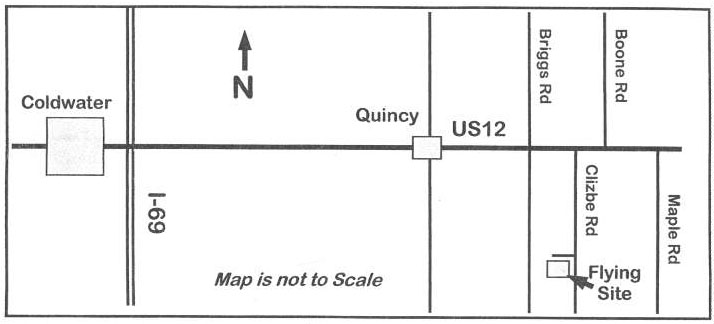
|
Dave Grife CD, 517-279-8445. Upcoming Cedar Rapids, Iowa E-Meet August 12-13, Electric Fun Fly Hosted by the Cedar Rapids Skyhawks of Cedar Rapids, Iowa.
Possible Future Projects for the Ampeer Readers
Given the recent reader reaction to the LCDC article, I began to wonder what interest there may be in other items - for the future. The attachment shows some home brew accessories I'm using with the popular CBA battery test device from West Mountain Radio. Bob 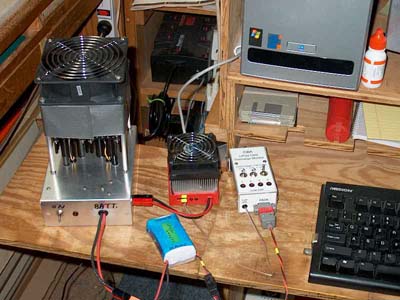
PHOTO INFO The tower-like item to the left of the CBA is a Power Amplifier. The battery under test plugs into it as do the normal CBA battery test leads. The Power Amplifier is electrically transparent, i.e., as far as the CBA is concerned; the battery is connected as usual to it.
Okay folks, are you interested? Let Bob know or let me know. We are here to give you what you want. KM Upcoming MISS Glider and Electric Flying Demo at Lyon Oaks Park Once again the Michigan International Soaring Society (MISS) has invited the EFO and local area electric fliers, to join them for their (MISS) flight demo on May 6, 2006 at the Lyon Oaks Park near the big Wixom auto plant and us. You MUST have your AMA card to fly. This was very successful last year. Tom Blazsak is once again organizing the event and has asked me to contact you about participating with your electric planes.
A Correction for the April Ampeer In the April Ampeer I wrote, "He told me that his nephew learned to fly the EasyStar very easily and that he has now recommended the Hitec Space Scooter for his nephew's second plane. This is an absolutely excellent way for anyone to get into this great hobby. KM"
Two Brushless Motors on One ESC Jim Houfek (houfekj@oclc.org) sent along the following: As to Tony Ives question on multi-engine ESC questions, take a look at the second article "Joe's Jabs: Brushless Multi-motor Power Systems" in the Castle Creations newsletter for March 2006. Here's to spring!! |
To Reach Ken Myers, you can land mail to the address at the top of the page. My E-mail
address is:
KMyersEFO@mac.com
EFO WEBsite: http://members.aol.com/KMyersEFO/



